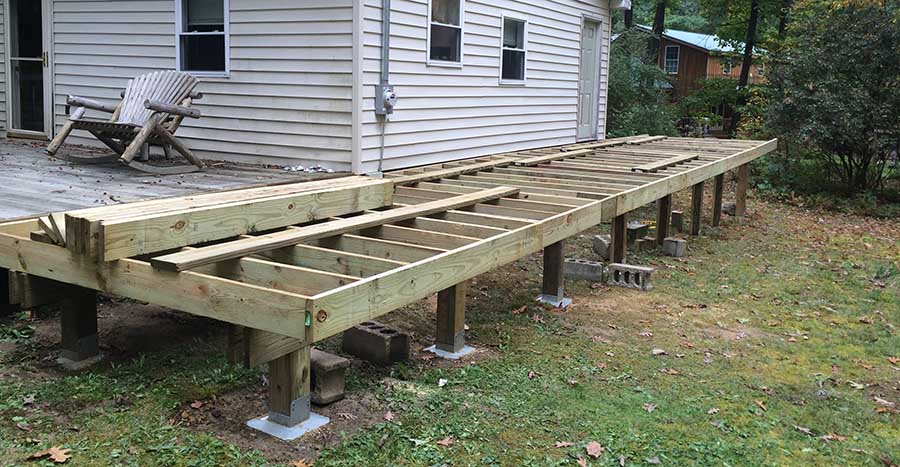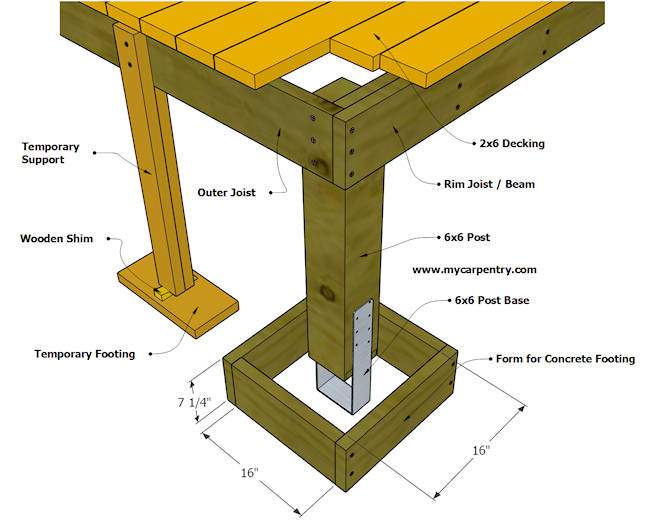Engineered for Success: The Science Behind Robust and Durable Deck Footings
Engineered for Success: The Science Behind Robust and Durable Deck Footings
Blog Article
Selecting the Right Deck Footings for Security and Longevity
When it concerns developing a deck, one of one of the most crucial decisions you will make is picking the ideal grounds for security and resilience. The longevity and security of your deck depend greatly on the type of footings you pick, as they supply the necessary support and stability to endure the test of time. With a myriad of choices readily available, it can be frustrating to determine which grounds are best suited for your particular needs. In this discussion, we will certainly check out the different types of deck footings, think about the vital elements to evaluate when choosing, and explore the pros and disadvantages of various alternatives. By the end, you will have a clearer understanding of the choices available and be better outfitted to make a notified decision for your deck task.
Sorts Of Deck Grounds
These grounds are composed of a cylindrical opening loaded with concrete, which provides a strong structure for the deck messages. Concrete pier footings are relatively very easy to set up and supply exceptional stability, making them a popular option for numerous deck jobs.
One more sort of footing is the helical stack footing. Helical piles are steel shafts with helical plates connected to them. These grounds are mounted by screwing them right into the ground, which develops a secure foundation for the deck. Helical heap footings are excellent for locations with difficult soil problems, as they can be installed in virtually any type of sort of dirt. If required., they additionally enable for simple change and progressing of the deck.
Additionally, some contractors select precast concrete grounds. These footings are constructed from sturdy concrete and come in numerous sizes and shapes to accommodate various deck designs. Precast concrete grounds are convenient to install and offer a steady base for the deck framework.
Lastly, an additional choice is the post-in-anchor footing system. This type of footing entails driving a steel support into the ground and attaching it to the deck message. It offers versatility in terms of positioning the deck articles and appropriates for decks with light-weight structures.
When selecting the ideal kind of deck footing, it is important to think about factors such as soil conditions, deck lots, and regional structure codes (Deck Footings). Consulting with an expert specialist or structural engineer can aid make sure the ideal footing is picked for a steady and safe deck
Factors to Consider When Selecting Footings
When picking the suitable footings for a deck, it is crucial to meticulously consider various variables such as soil conditions, deck load, and adherence to regional building regulations. These variables play a considerable role in making sure the security and toughness of the deck structure.
Among the main variables to take into consideration is the soil conditions. The kind of soil on which the deck will be constructed establishes the type of footings called for. For example, decks improved sandy or loose dirts may call for much deeper grounds to give ample support and prevent settling. On the various other hand, decks developed on clay or large soils may need grounds that can accommodate the dirt's tendency to expand and agreement.
Another essential element is the deck load. The weight of the deck, consisting of the materials used and any type of potential online loads such as furnishings or events, should be taken into account when selecting footings. The footings should be developed to birth the weight of the deck and distribute it equally to stop any kind of architectural problems or failings.
Last but not least, adherence to local building regulations is critical. Building codes differ from region to area, and it is important to adhere to the particular needs set by the regional authorities. Deck Footings. These codes make certain that the deck is built securely and satisfies the required criteria for architectural integrity and load-bearing capability
Concrete Grounds: Advantages And Disadvantages

Concrete grounds use a number of advantages and negative aspects when utilized as the foundation for a deck. On the positive side, concrete footings offer outstanding security and toughness.
Another benefit of concrete grounds is their convenience. They can be poured into various sizes and shapes to accommodate numerous deck styles and configurations. Concrete grounds can be customized to fit the details needs and needs of the deck structure.
Nevertheless, there are likewise some disadvantages to making use of concrete grounds. This can increase the overall price of the deck task and might need specialist assistance.

Helical Piers Vs. Sonotubes: Which Is Better?
In thinking about the structure options for a deck, the comparison in between helical piers and sonotubes is important in establishing the superior selection. They are twisted into the ground using hydraulic machinery, supplying a sturdy and stable structure for the deck.
The helical plates on the piers develop a solid grasp with the soil, shifting or avoiding any activity of the deck. Sonotubes, on the various other hand, depend entirely on the concrete filling for stability, which may not provide the same degree of toughness and resistance.
In regards to installation, helical piers are fairly much easier and faster to check over here set up contrasted to sonotubes. The hydraulic machinery made use of to turn the piers into the ground makes sure a effective and fast process. Sonotubes, on the various other hand, call for excavating holes and pouring concrete, which can be lengthy and labor-intensive.
Additionally, helical piers are an even more flexible alternative. If required, they can be utilized in different dirt problems and can be adjusted or strengthened. Sonotubes, on the other hand, might require extra support, such as rebar, in particular dirt conditions or areas with high load demands.
Selecting the Right Footings for Your Deck's Measurements
For optimal structural stability, it is vital to very carefully select the proper grounds that straighten with the dimensions of your deck. The measurements of your deck, including its elevation, size, and size, play a significant duty in establishing the type and size of grounds needed.
When choosing grounds for your deck, it is essential to consider the load-bearing capability of the dirt. The weight of the deck, incorporated with the weight of any kind of furnishings or individuals on it, applies a considerable force on the footings (Deck Footings). Consequently, it is important to select grounds that can sufficiently sustain this weight without changing or sinking gradually.
The shapes and size of the grounds need to additionally be considered. Bigger decks with greater dimensions need bigger grounds to provide sufficient security and assistance. The form of the grounds, whether they are square or round, relies on the style and format of the deck. Additionally, the deepness at which the footings are mounted ought to be determined based upon the frost line in your region to protect against any kind of heaving or moving due to freezing temperatures.
Final Thought
Finally, selecting the best deck footings is essential for guaranteeing security and longevity. Elements such as the kind of footings, the deck's dimensions, and the pros and disadvantages of various options ought to be thought about. Concrete grounds provide toughness and longevity, yet might be more costly and taxing to mount. Helical piers and sonotubes have their very own advantages and drawbacks. Ultimately, picking the proper footings for your deck's certain requirements is necessary for a long-lasting and effective framework.
These grounds consist of a cylindrical hole filled up with concrete, which provides a strong foundation for the deck articles. Concrete pier grounds are fairly easy to install and use excellent stability, making them a preferred choice for check out here numerous deck projects.
Precast concrete grounds are practical to mount and provide a steady base for the deck structure.
It informative post offers adaptability in terms of positioning the deck messages and is suitable for decks with lightweight structures.
Concrete footings use several advantages and downsides when utilized as the foundation for a deck.
Report this page